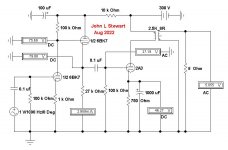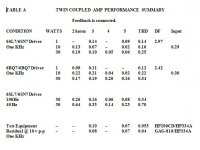Had you not pointed that out I'd never have known!! 😱Power pentode and voltage amplifier pentode are somewhat different beasts.
😀
I wanted to put it in a proper chassis, then life got in the way, and now I am enjoying AM radio ;-)Why such cool thing "decomissioned"?!
Sorry, didn't mean anything condescending or disrespectful. Your circuit was triode half of 6LU8 driving pentode half of the same, the pentode part being power amplifier. I was proposing either triode, or pentode half of 6AG9 as driver.Had you not pointed that out I'd never have known!! 😱
😀
You will have it again. Once tube nut, always tube nut, no matter what life throws at you...I wanted to put it in a proper chassis, then life got in the way, and now I am enjoying AM radio ;-)
I am struggling to understand it. The first stage seems to operate at a very non-linear low voltage low current region for this type of tube. Why not running it at its recommended high current? Plate resistance would be low enough to make the cathode follower unnecessary. Then, on top of it, this isn't exactly one of the most linear triodes.Another Alternative. First Pass.
One volt at the input drives the 2A3 to clipping. 👍
If additional CF stage is considered, a pentode driver can be very substantially improved. Like E80F/C.F. driver with less than 0.2 Vrms in and less than 1% driver THD at 2A3 clipping.
Last edited:
As the short note sez, it is a first pass. The first stage plate current is 1.77 mA. In this sim I’m simply looking at cct voltage & current levels.
The finale version was to be a small pentode triode. There are a few suitable, for example the 6AN8 or 6U8. I rejected several others since the Pd of their triodes was not high enough to support the high current of the CF.
Many underestimate the performance of these meant for TV & FM tubes. While doing the performance tests on my take of Crowhurst’s Twin Coupled Amp I put together two adapters for the amp front end, a two stage differential amplifier. The 6SL7 & 6SN7 were replaced with 6BQ7’s. The measured performance is much better than most would have thought. Primarily because they heard what others were saying but never tried to check the results themselves. The distortion measurements were taken by a PicoTech virtual instrument & an HP 334A THD meter.
There are a few designers with vacuum tube experience here on DIY. The rest simply throw darts & hope for a good outcome.
The finale version was to be a small pentode triode. There are a few suitable, for example the 6AN8 or 6U8. I rejected several others since the Pd of their triodes was not high enough to support the high current of the CF.
Many underestimate the performance of these meant for TV & FM tubes. While doing the performance tests on my take of Crowhurst’s Twin Coupled Amp I put together two adapters for the amp front end, a two stage differential amplifier. The 6SL7 & 6SN7 were replaced with 6BQ7’s. The measured performance is much better than most would have thought. Primarily because they heard what others were saying but never tried to check the results themselves. The distortion measurements were taken by a PicoTech virtual instrument & an HP 334A THD meter.
There are a few designers with vacuum tube experience here on DIY. The rest simply throw darts & hope for a good outcome.
Attachments
That seems harsh, misplaced and makes too many assumptions.There are a few designers with vacuum tube experience here on DIY. The rest simply throw darts & hope for a good outcome.
It's not hard to design and build a tube amplifier.
This is supposed to be fun, remember?.
--
jdrouin: how are you going with your 2A3 adventures?
Last edited:
It's easy to build something to 1930's standards of performance, although even that, at its best, was a pretty demanding standard. And it's easy to build something to 1950's standards of safety, but just don't. But are either of these the goal of modern DIY builders? I would argue that, except for Sakuma "I adjust by smell" specialists, most folk want to build something that is the best that they can make it. "Best" is a big word and will forever be discussed, of course.
Folk like jhs have probably seen too much foolishness, too many commonly repeated errors, too much voodoo and reptile extracts, too much worship of pre-War circuitry, and would like to start newer devotees off on a better footing than is often printed elsewhere. DIYaudio is helpful in this because it encourages immediate corrections to errors in thinking and modeling, saving folk valuable time. These corrections are not criticisms or personal insults - instead, they are the highest form of compliments. "You are worth my time to give this correction." That's what DIYaudio is about.
All good fortune,
Chris
Folk like jhs have probably seen too much foolishness, too many commonly repeated errors, too much voodoo and reptile extracts, too much worship of pre-War circuitry, and would like to start newer devotees off on a better footing than is often printed elsewhere. DIYaudio is helpful in this because it encourages immediate corrections to errors in thinking and modeling, saving folk valuable time. These corrections are not criticisms or personal insults - instead, they are the highest form of compliments. "You are worth my time to give this correction." That's what DIYaudio is about.
All good fortune,
Chris
Just a friendly reminder that the original poster outlined five 2A3 established designs that he would build and evaluate - thats all."..most folk want to build something that is the best that they can make it. "Best" is a big word and will forever be discussed, of course."
Kind regards
---
jdrouin: how are you going with your 2A3 adventures?
Last edited:
As I wrote it is better to build something that is certified by test lab.
And, as usual, the quality is strictly related to the quality of OT trafo, first.
cit.
When you can measure what you are speaking about,
and express it in numbers, you know something about it;
but when you cannot measure it, when you cannot express it in numbers,
your knowledge of it is of a meager and unsatisfactory kind:
it may be the beginning of knowledge, but you have scarcely,
in your thoughts, advanced to the stage of science.
William Thomson, Lord Kelvin of Largs (1824-1907)
And, as usual, the quality is strictly related to the quality of OT trafo, first.
cit.
When you can measure what you are speaking about,
and express it in numbers, you know something about it;
but when you cannot measure it, when you cannot express it in numbers,
your knowledge of it is of a meager and unsatisfactory kind:
it may be the beginning of knowledge, but you have scarcely,
in your thoughts, advanced to the stage of science.
William Thomson, Lord Kelvin of Largs (1824-1907)
Last edited:
Hi,
This is Gerrittube from The Netherlands. I am not involved in this. Please leave me out of your discussions!
Regards, Gerrit
This is Gerrittube from The Netherlands. I am not involved in this. Please leave me out of your discussions!
Regards, Gerrit
Probably the one that is drunk is not meATT MODS:
I suspect waltube is double account with gerritube - please investigate
Cheers 🙂
🙂
Walter
I cant help but notice that "gerritube" has retracted his 'support' for "waltube" - what a coordinated effort; who knew.
Anyway, you hyenas are a perfect example of why otherwise good people stay away from here.
---
jdrouin: how are you going with your 2A3 adventures?
Anyway, you hyenas are a perfect example of why otherwise good people stay away from here.
---
jdrouin: how are you going with your 2A3 adventures?
Last edited:
Maybe you should investigate why he left the thread.I cant help but notice that "gerritube" has retracted his 'support' for "waltube" - what a coordinated effort; who knew.
Anyway, you hyenas are a perfect example of why otherwise good people stay away from here.
---
jdrouin: how are you going with your 2A3 adventures?
Chris - I really like what you say. There are straightforward, unquestionanle paths to goodness, like choosing most linear tubes, finding operating points with least distortion, understanding both advantages and limitations of different topologies. A rational designer follows these paths and hopes for good outcome. Hopes, but is not assured of. There are many things that nobody understands well, which can make a difference between "good" and "best".I would argue that, except for Sakuma "I adjust by smell" specialists, most folk want to build something that is the best that they can make it. "Best" is a big word and will forever be discussed, of course.
Gentlemen,
When you tried to get me “involved”, I withdrew my support for both of you. I guess that’s within the forum rules…
Regards, Gerrit
When you tried to get me “involved”, I withdrew my support for both of you. I guess that’s within the forum rules…
Regards, Gerrit
Last edited:
- Home
- Amplifiers
- Tubes / Valves
- Developing a 2A3 SET



 Gentlemen. Please stay on topic. The topic is NOT each other. Trolling is against the rules. Someone is now locked out of this thread for a week. Let's see if that calms the waters.
Gentlemen. Please stay on topic. The topic is NOT each other. Trolling is against the rules. Someone is now locked out of this thread for a week. Let's see if that calms the waters.